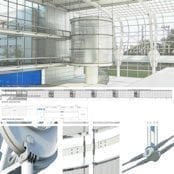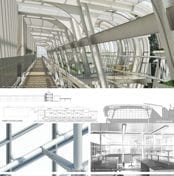by LeeAviv
Over the last century, architects have aimed at incorporating spirituality into the economical advantages of using steel as a structural material in building. From the patterned ornamentation of structural members in the work of Louis Sullivan to the poetic expression of technological advance in the work of Mies van der Rohe to the tectonic exploration of structural connections in the work of Renzo Piano, every attempt has been made to infuse the structural system with more than utilitarian considerations. Spirituality did not refer to particular religion here, but to a harmony between the self and everything else. While steel continues to be a fundamental building material in urban American construction—in fact, entire church buildings are available from pre-fab steel websites—the majority of applications lacks any reference to a deeper meaning.
At a time when architects are beginning to explore a variety of alternative or “new” materials, the Association of Collegiate Schools of Architecture and the American Institute of Steel Construction organized a competition to spearhead the exploration of the use of steel in the production of spiritual space. The chosen projects focused generally on the materiality of steel and the forms possible through the use of structural steel. Through two different categories, the competition presented twelve different innovative uses of steel, and reminded us of the unique experiential qualities that the use of steel provides potential for.
The jury composition, while small in size given the scale of the competition, included a diverse group of reviewers that more than adequately evaluated over 450 projects according to criteria related to the production of spiritual space, the functional requirements of the program, and the structural feasibility of the proposals. 1409 students from 75 schools participated in the competition (both categories combined) and about three percent of the submissions received awards.
By requiring a program for an institute that seeks to promote a reconnection between the self, others, and nature, the first category encouraged participants to inquire into the potential of steel architecture to respond to the human condition of “being” rather than the processes of production and consumption that so dominate everyday American life.




The first prize in this category was awarded to Will Allport, Nick Barrett, and Jason Butz, fourth year architecture students from Clemson University. The project, titled [sub]conscious suspension, was chosen for its integration of the urban condition, individual experience, and response to the steel issue. According to the faculty sponsor Dan Harding, the success of the project stemmed from being able to filter design issues through “the human experience and the intrinsic qualities found in building materials.” This allowed the project to transcend category, rather focusing on the human condition and the nature of building. The spaces featured varieties of materials including exposed structural steel, vegetated walls, unfinished concrete, and Corten light wells. According to the authors, the spaces of the project supported spirituality by linking opposite atmospheres (related to mind and body) through materiality.




The second prize was awarded to Stephen Bonamy and Michael Fontana from Lawrence Technological University. Titled The Vertical Landscape, the project was chosen due to its attention to the experience of the building and it incorporated a coated tubular steel structural skin. As pointed out by the faculty sponsors, the project obtained its cultural critique through the formation of a tessellated structure, the site selection, and the integration of the landscape. The result was the conception of a building in which progression through is stimulating, unfamiliar, and varied, incorporating the public and attacking notions of consumerism.
Five honorable mentions were awarded which examined the use of steel in the exploration of sound as a generator of spatial organization, the relation between building and landscape, the reprogramming of abandoned infrastructure, the individual’s transition from “doing” to “being,” and the variety of scales present in urban conditions. Though each awarded submission interpreted the program differently, each made a case for steel as the chosen material for a spiritual space in urban conditions—as opposed to the traditional uses of stone or wood.




The second category remained open to any program and required only that a steel structural system be used. The first prize for this category was awarded to Daniel Cesarz from the University of Wisconsin-Milwaukee. The project was chosen due to the attention to detail in steel construction. It featured an exposed long-span steel structure with a repetitive profile, which according to the sponsors relates to the post-industrial remnants of steel structures in the city. The project focused heavily on the expression of steel structural connections.




The second prize was awarded to Cody James Glen, Salvador Cabezon, and Maria A. Sanchez Casella from Woodbury University and the University of Buenos Aires. RE.COVER//, a proposed water filtration building along the polluted Riachualo River in Buenos Aires, was chosen due to the siting of the building in relation to circulation as well as the materiality of the building skin. Through the expression of structural connections and a play between materiality and space, the project poetically presented steel as a sustainable material.




The third prize was awarded to third year student Dion Dekker of California Polytechnic State University. His project investigated the potential use of shipping containers in building construction. The tower was composed of a modular steel structural skeleton incorporating a variety of configurations of reused shipping containers with programmatic functions.
Honorable mentions included another project for a water filtration plant and an experimental steel living unit. Although the second category did not require an attention to spirituality, most of the awarded projects suggested such a theme through the form of the structures and the experiences of the buildings.
As in previous years, the competition was successful in bringing various innovative uses of steel to our attention. Unfortunately, the competition failed to acknowledge the limits of the material. Although some of the submissions represented the structures as being concealed, the majority of the awarded projects presented large-scale buildings, amongst them some tall towers that glorified the materiality of exposed steel in situations where steel structures usually have to be fire-coated and are thus concealed from view. Architects such as Renzo Piano and Daniel Libeskind among others have often unsightedly encountered this issue late in the design process, and as a result, have constructed elegant structural systems only to be covered in gypsum board. Despite this requirement, steel structures can still be expressed, but the methods of fire-retardation need to be considered throughout the design process. As an academic endeavor to explore tectonics, the experimentation of exposed steel works well. But as a promotion for the use of steel in large building structures or considering the future of the profession, the competition failed to acknowledge the realistic requirements of building.
Lee Aviv is assistant to the editor of Competitions.

































